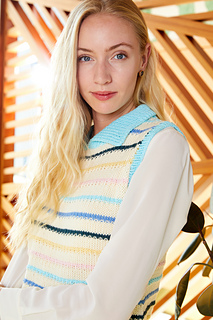patterns >  Seaside Supreme and 1 more...
Seaside Supreme and 1 more...
> Mainsail Tank









Mainsail Tank
Collared tops add an effortless sophistication to any outfit. Dressed up or down for the day’s needs; you will always look polished. Mainsail combines six colors of our Cotton Supreme DK yarn for a delicately striped polo tank that feels perfect for a day on the lake or at the country club. Pair with the matching Mainsail Shawl for a put-together twinset you’ll reach for again and again.
DIFFICULTY
Easy
SIZES
Extra Small (Small, Medium, Large, 1X, 2X, 3X, 4X, 5X)
Shown in Small size with approx. 5” of positive ease.
FINISHED MEASUREMENTS
Bust: 32½ (36½, 40½, 44½, 48½, 52½, 60½, 64½)”
Length: 22 (22½, 23, 24, 24½, 25, 26, 26½, 26½)”
MATERIALS
Universal Yarn Cotton Supreme DK (100% cotton; 100g/230 yds)
702 Ecru (A) – 2 (2, 3, 3, 3, 3, 4, 4, 4) skeins
732 Hosta (B) – 1 skein (all sizes)
706 Azure (C) – 1 skein (all sizes)
716 Aqua (D) – 1 (1, 1, 1, 1, 1, 2, 2, 2) skeins
705 Pink (E) – 1 skein (all sizes)
707 Yellow (F) – 1 skein (all sizes)
Needles: US Size 7 (4.5 mm) 32” circular or size needed to obtain gauge
US Size 6 (4 mm) 32” circular, 16” circular, and set of DPNs (or your preferred needle for knitting small circumferences)
Notions: Tapestry needle, stitch markers, stitch holders or waste yarn
GAUGE
20 sts x 28 rows = 4” in Stockinette stitch (St st) with larger ndl
Save time, check your gauge.
PATTERN NOTES
This top is knit from the bottom up in the round. The front and back hem are knit separately first, then are joined together and the body is knit in the round. The front and back are separated at the underarm and worked flat. Stitches for the armhole edging are picked up and knit in the round. The neckband is picked up and knit in the round for a few rounds, then is worked flat to create the polo collar.
When changing colors, do not break color A at color changes. Instead, carry the yarn up loosely along the inside or side of work.
892 projects
stashed
984 times
- First published: April 2021
- Page created: April 26, 2021
- Last updated: April 26, 2021 …
- visits in the last 24 hours
- visitors right now




